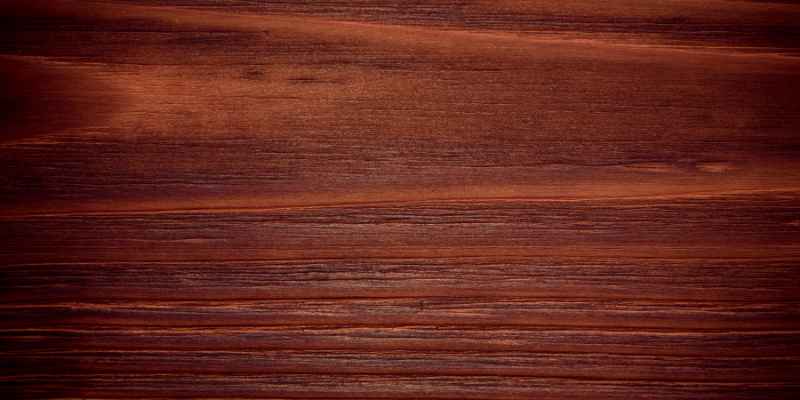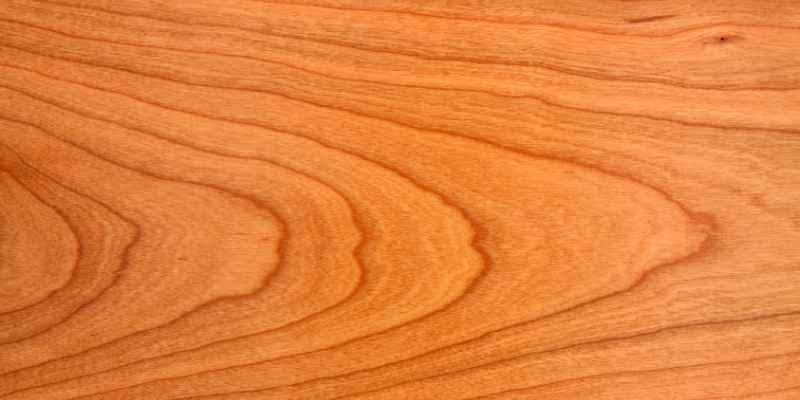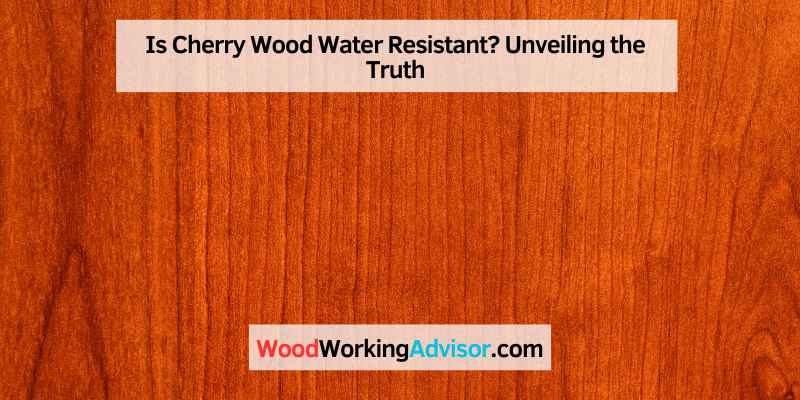Cherry wood is not inherently water-resistant due to its porous nature. However, it can be treated to enhance its water resistance.
Cherry wood is a popular choice for furniture and flooring due to its rich color and smooth texture. While it adds warmth and elegance to any space, its susceptibility to water damage is a concern for many. Understanding how to properly care for cherry wood can help maintain its beauty and longevity.
By applying sealants or finishes, cherry wood can be protected from moisture and potential water damage. Proper maintenance and regular inspections can help preserve the quality of cherry wood products for years to come.
Introduction To Cherry Wood
Cherry wood boasts natural beauty but lacks inherent water resistance, making it susceptible to moisture damage without proper sealing. Maintaining cherry wood furniture or flooring involves diligent care to prevent water-related issues. Regular maintenance and protective measures are vital to preserve the longevity of cherry wood items.
Cherry wood is a popular hardwood that is widely used in the furniture industry. It is known for its beautiful, rich color and smooth texture. Cherry wood is a slow-growing tree, which makes it a valuable and expensive wood.
Characteristics
Cherry wood has a distinctive reddish-brown color that darkens with age. Its grain is straight and fine, with a smooth texture. Cherry wood is a durable and strong hardwood that is resistant to wear and tear. It is also easy to work with and can be carved, turned, and polished with ease.
Common Uses
Cherry wood is a popular choice for furniture, cabinets, and flooring. Its warm color and elegant grain pattern make it a favorite among woodworkers. Cherry wood is also used in the production of musical instruments, such as guitars and pianos, due to its excellent tonal properties. Additionally, cherry wood is used in the production of decorative items such as bowls, cutting boards, and picture frames.
Is Cherry Wood Water Resistant?
Cherry wood is not naturally water-resistant, and it can absorb moisture if left untreated. However, it can be made water-resistant by applying a protective finish such as polyurethane or varnish. These finishes help to seal the wood and prevent moisture from penetrating the surface. It is important to note that even with a protective finish, cherry wood should not be exposed to excessive moisture or water for extended periods.
The Quest For Water Resistance In Woods

Why Water Resistance Matters
Water resistance is a crucial factor to consider when selecting wood for various applications. Exposure to moisture can lead to warping, rot, and decay, compromising the structural integrity of wooden items. Water-resistant wood can withstand these challenges, ensuring longevity and durability.
Comparing Different Woods
When evaluating water resistance, it’s essential to compare the properties of various woods. Cherry wood, known for its rich color and fine grain, is a popular choice. However, its water resistance may not match that of teak or cedar. Understanding these differences is vital when selecting wood for specific projects.
Cherry Wood Under The Microscope
Cherry wood is a popular choice for furniture and flooring due to its warm color and beautiful grain patterns. But have you ever wondered about its physical properties and how it interacts with water? Let’s take a closer look at cherry wood under the microscope.
Physical Properties
When it comes to physical properties, cherry wood is known for its medium density and moderate strength. It has a Janka hardness rating of 950, which is considered relatively soft compared to other hardwoods. Additionally, cherry wood has a fine, straight grain with a smooth texture, making it easy to work with and finish.
One interesting aspect of cherry wood is its natural color change over time. When freshly cut, cherry wood has a light pinkish hue, but it darkens to a rich reddish-brown color with exposure to light. This color change is a unique characteristic of cherry wood and adds to its appeal.
Water Interaction
While cherry wood is a durable hardwood, it is not inherently water-resistant. It is important to note that cherry wood can absorb moisture if exposed to water for prolonged periods or in high humidity environments. This moisture absorption can lead to warping, swelling, and potential damage to the wood.
However, proper finishing and maintenance can enhance cherry wood’s resistance to water. Applying a protective finish, such as polyurethane or lacquer, creates a barrier that helps prevent moisture from penetrating the wood. Regular cleaning and avoiding excessive exposure to water can also help maintain the wood’s integrity.
It is worth mentioning that even with protective finishes, cherry wood should not be submerged in water or used in areas with constant moisture exposure, such as bathrooms or kitchens. Using coasters, mats, or tablecloths can help protect cherry wood surfaces from water damage.
In conclusion, while cherry wood offers many desirable qualities, it is not inherently water-resistant. However, with proper care and maintenance, cherry wood furniture and flooring can withstand occasional contact with water without significant damage.
Scientific Insights On Cherry Wood And Water
Scientific insights on cherry wood and water provide valuable information for understanding its water resistance. Let’s delve into the studies, experiments, and expert opinions on this intriguing topic.
Studies And Experiments
Several studies and experiments have been conducted to assess the water resistance of cherry wood. Researchers have subjected cherry wood samples to prolonged water exposure under controlled conditions to evaluate their ability to resist water penetration and damage.
Expert Opinions
Experts in the field of wood science and forestry have shared insightful perspectives on the water resistance of cherry wood. Their collective expertise sheds light on the unique properties of cherry wood and its interaction with water, providing valuable insights for consumers and industry professionals alike.
Real-world Applications And Considerations
When considering the water resistance of cherry wood, it’s important to understand its real-world applications and the considerations that come with it. Whether used indoors or outdoors, cherry wood’s natural properties make it suitable for a variety of uses. However, maintenance and environmental factors play a crucial role in determining its longevity and performance.
Outdoor Vs. Indoor Use
Cherry wood can be used both indoors and outdoors, but its performance in these settings varies. When used outdoors, cherry wood requires additional protection to withstand the elements. Sealing the wood with a weather-resistant finish is essential to enhance its water resistance and prevent damage from moisture and UV exposure.
Maintenance Tips
Proper maintenance is key to preserving cherry wood’s water resistance and overall quality. Regularly applying a protective sealant can help maintain its resistance to water and other environmental factors. Additionally, keeping cherry wood clean and dry, and avoiding prolonged exposure to harsh weather conditions, can significantly extend its lifespan.
Protecting Cherry Wood From Water Damage
Cherry wood is not naturally water-resistant, making it vulnerable to damage when exposed to moisture. Proper care and protective measures are essential to maintain the beauty and longevity of cherry wood furniture.
Sealing And Finishing Options
Sealing: Apply a waterproof sealant to create a protective barrier against moisture.
Finishing: Use a high-quality finish to add an extra layer of protection and enhance the wood’s natural beauty.
DIY Protective Measures
- Regular Maintenance: Wipe off spills immediately to prevent water penetration.
- Use Coasters: Place coasters under glasses and mugs to avoid water rings.
- Avoid Direct Sunlight: Sun exposure can damage cherry wood, leading to cracks.
Myths Vs. Facts: Debunking Misconceptions
Common Myths
Cherry wood is not water resistant.
Cherry wood gets easily damaged by water.
The Truth Revealed
Cherry wood is naturally water resistant.
Cherry wood has a fine grain that repels water.
Final Verdict: Is Cherry Wood Water Resistant?
Final Verdict: Is Cherry Wood Water Resistant?
Analyzing The Evidence
Cherry wood’s water resistance depends on sealing and maintenance.
Making An Informed Decision
Consider the type of finish and usage to determine water resistance.

Frequently Asked Questions
Is Cherry Wood Water Resistant?
Cherry wood is not water-resistant and is not recommended for outdoor use or areas with high moisture levels. However, it can be treated with a water-resistant finish to improve its durability and protect it from moisture.
Can Cherry Wood Be Used For Bathroom Cabinets?
Cherry wood can be used for bathroom cabinets, but it is not recommended due to its lack of water resistance. If used, it should be treated with a water-resistant finish and proper care should be taken to avoid prolonged exposure to moisture.
How Do I Care For My Cherry Wood Furniture?
To care for your cherry wood furniture, avoid placing it in direct sunlight or near sources of heat. Use a soft, dry cloth to dust it regularly, and avoid using harsh chemicals or abrasive materials. You can also apply a furniture polish or wax to maintain its luster.
Is Cherry Wood Durable?
Cherry wood is a durable hardwood that is known for its strength and durability. With proper care and maintenance, cherry wood furniture can last for generations.
Conclusion
To conclude, cherry wood possesses a natural resistance to water due to its dense grain structure and high levels of natural oils. This makes it less prone to warping, swelling, and rotting when exposed to moisture. However, it is important to note that cherry wood is not completely waterproof and proper care and maintenance are necessary to ensure its longevity.
Regular sealing and protection against excessive water exposure will help preserve its beauty and durability over time. So, while cherry wood has inherent water resistance qualities, it is advisable to take precautions to maintain its integrity.


